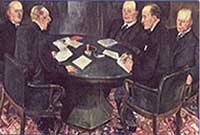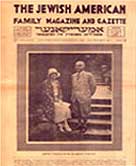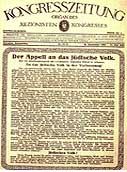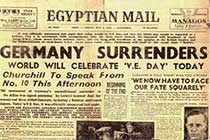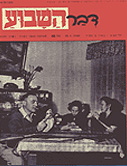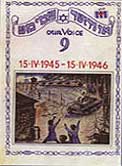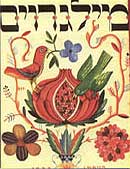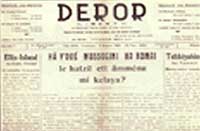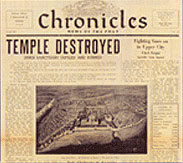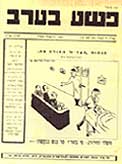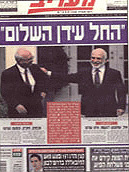


Jews were prominent in the world press from the 19th century onward. Their influence was especially pronounced in Germany - as publishers, editors and journalists. Two large publishing concerns headed by Jews - Ullstein and Mosse Publishers - played so important a role that such highly regarded newspapers published by them as the Berliner Tageblatt and the Berliner Morgenpost (the most widely circulated newspaper in Germany at the end of the 19th century) were labeled "Judenpresse". With the rise of Hitler to power, Jewish press activity in Germany came to an end.
Leopold Ullstein's five sons, who ran the family business (l. to r.): Hermann (head of the magazine and book division), Rudolf (technical manager), Franz (managing editor), Ludwig (business manager following the death of Leopold Ullstein), and Hans (legal counsel of the firm).
The first generation of immigrant Jews in the United States depended on the Yiddish press - both daily and periodic - in order to learn about the new world. A weekly, titled The Jewish American, which first appeared in 1904, filled this need admirably, reporting on cultural and social life in New York. Aimed at the common people, it gained their loyalty and operated successfully for some 60 years. The Jewish American closed in 1963 but appeared thereafter as a supplement in the Yiddish The Morning Journal.
The Jewish American cover pages featuring celebrities from the early 1930s: Governor (later Senator) of New York Herbert Lehman with his wife Edith.
Advertising, an integral component of the press, plays a role not only in sustaining newspapers financially but, retrospectively, in revealing a great deal about the ideologies of their publishers, advertisers and readers.
The subject of the cover page of L'Avenir Illustre, a Jewish weekly in French that appeared in Casablanca, Morocco, is a contented baby who drinks evaporated sweet milk manufactured by the giant Swiss Nestle Company. Issue of 1937.
Zionist newspapers appeared throughout the world in various languages, each attempting in its own way to advance the establishment of a Jewish state in Eretz Yisrael.
Kongresszeitung, the newspaper of the 13th Zionist Congress, held at Carlsbad, Czechoslovakia, 15 September 1921. The Zionist Congresses, which took place two years in Europe during the 1920s and '30s, published a daily newspaper during the event. Most often these papers were printed in German, but from 1935 onward they were published in Hebrew as well.
The press followed the Second World War for nearly six years, at first forced to report German victories but later, when the tide turned, covering defeat after defeat by Germany. On 7 May 1945, the newspapers reported Germany's final defeat.
The Egyptian Mail, published in Cairo, was edited by a Jewish journalist, D.I. Goldstein. Shown, the issue of 8 May 1945 celebrating the 'V.E. Day'.
"The greatest year of all" was how Jews referred to the Hebrew year 5708 which began with the U.N. decision in November 1947 to create a Jewish state and ended with the final phase of Israel's War of Independence. The excitement of the moment was palpable not only in the Jewish press of Palestine but in the entire Jewish world.
A typical cover page of 1948 in Dvar ha'shavua, March 18th : An average family at home preparing for the establishment of the state. From the collection of the late Shoshana and Chaim Rothman.
Unzer Sztime was published in the Bergen-Belsen Displaced Persons camp after the Second World War. A collection of all 24 issues published was contributed to the Institute by the original editors, Rafael Olevski, Paul Trepman and David Rosental.
The first issue appeared two months after the end of the war, on 12 July 1945 written by hand. On the front page: "Yizkor" for those who perished in the Holocaust. On 15 April 1946, a year after the liberation of the camp by the American army, the paper published an issue that was exceptional for the conditions then - a printed edition with a color front page.
The Yiddish-language Milgroim ("Pomegranate"), an unusual periodical that appeared in Germany in the early 1920s, was published side by side with a Hebrew version, Rimon. Based in Berlin, both were bimonthlies elegantly designed and printed in qualitative color on fine paper, far ahead of their time. Both publications were devoted to the arts, with an emphasis on universalism and modernism.
First issue of Milgroim (Berlin, spring 1922). From the collection of Hannah and Mordecai Halamish.
This unusual weekly was published in Hebrew printed in Latin letters for a brief period in Palestine in 1933. Its founder and editor was Ittamar Ben-Avi, son of the renowned Hebrew lexicographer Eliezer Ben-Yehuda. Ben-Avi, a journalist, believed that Latin script should replace the Hebrew script (which itself was not Jewish at all but rather Assyrian) in order to ease the adjustment of new immigrants from Germany as well as to widen out the audience for Hebrew. "Only Latin letters, heirs to our ancient letters, will open the gates of the wide world around us to our language and to its rich literature," he wrote. The weekly, however, failed, and Ben-Avi was widely criticized for abandoning the Hebrew alphabet.
From Rafi Grafman's collection.
Someone once defined the press as the first draft of written history: the content of the newspaper today will in time become the basis for the writing of history. Rarely, however, does the reverse occur: history written in newspapers. This is precisely the case with the newspaper series entitled Chronicles (in Hebrew, Divrey Ha'yamim), which appeared in Jerusalem in the early 1950s, edited by Dr. Israel Eldad. Published in 48 volumes, the series was initially written in Hebrew and later translated into English. The exhibit shows examples from several volumes. The series was reprinted in bound hard-cover editions on the tenth anniversary of Israel (1958), after the Six Day War, and in the early 1990s. Eldad was a sworn political enemy of Israel's first prime minister, David Ben Gurion, yet the two shared a deep appreciation of the Bible and a view of it as an important underpinning of Israel's revival. Ben Gurion ordered the Israel Defense Forces to acquire large quantities of the series for distribution to soldiers.
Jewish humor is well known, and Jews frequently laughed at themselves, both in good times and in bad, often in their press. Every self-respecting Jewish paper had a humor column that included features, jokes and caricatures. Moreover, special humor newspapers appeared periodically. Pointed, biting satire often played a large role in this material.
The British Mandate government was often targeted for attack as the "alien regime." Humor and satire newspapers flourished in Eretz Yisrael then. A one- time example that appeared before the Purim holiday in 1938 was Pesha Ba'erev ("Crime in the Evening"), a parody of a popular weekly then, Tesha Ba'erev ("Nine in the Evening"), edited by Uri Kesari.
From the time of the establishment of the State of Israel, the press has followed the country's political, security, cultural and all other events day by day. Not all newspapers survived throughout the 50 years. Many faltered along the way. In fact, of the many newspapers that appeared with the establishment of the state, only five have remained: Ha'aretz, Yediot Aharonot, Ma'ariv, Hatsofeh and The Jerusalem Post. The newspapers shown here reflect the wide range of subject matter covered by the Israeli press, as well as various developments in it, from news on important topics - some happy and some sad, to an issue nearly devoid of any news, to the final issue of a newspaper.
Ma'ariv, 26 July 1994. "The Beginning of a Peace Era": the Israeli prime-minister Yitzhak Rabin and King Hussein of Jordan at the White House in Washington.
